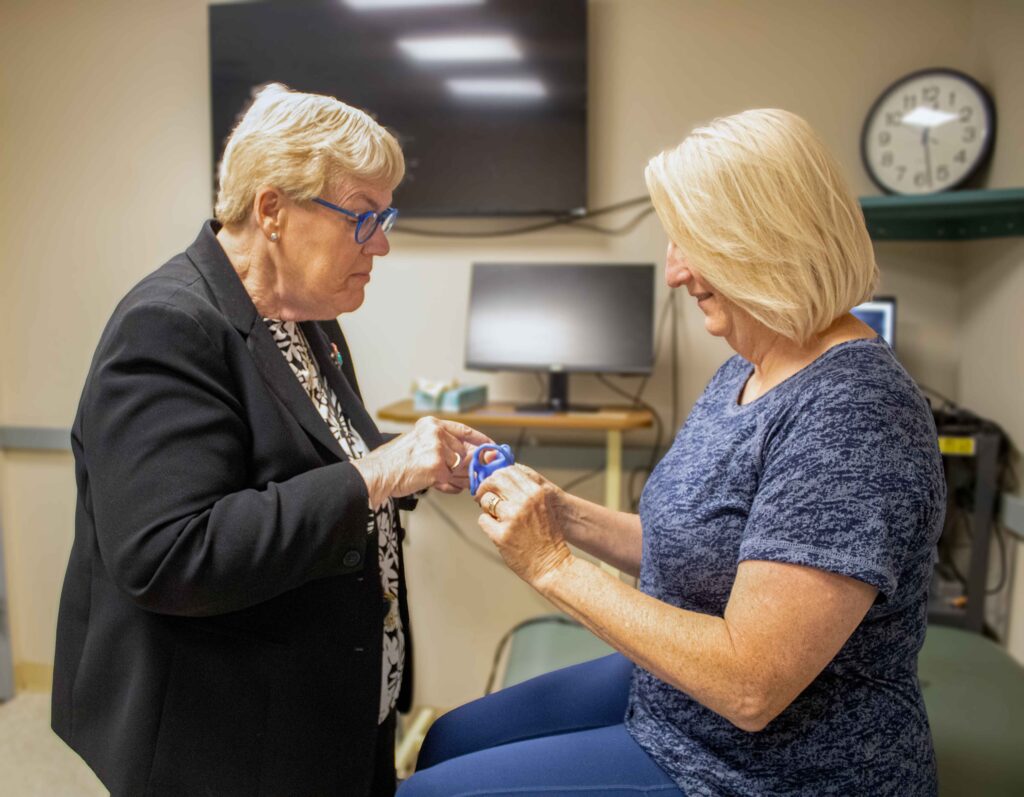After practicing as a physical therapist at UPMC for over 38 years, Susan George was enjoying being a grandmother. Suddenly, she began losing her balance a little bit here and there, which never used to happen. Despite being born with one leg, she was surprisingly sure-footed.
Joseph Furman, MD, PhD, FAAn, Director of the UPMC Center for Balance Disorders, confirmed that one of her vestibular nerves was no longer working. For someone with two legs, the other vestibular nerve would likely have fully compensated. For Susan, the single remaining vestibular nerve on the right could not adequately compensate.
Susan knew immediately who she would see for her vestibular dysfunction: Susan Whitney, DPT, PhD, NCS, ATC, FAPTA, Director of the Vestibular Rehabilitation Program, whom she called the “vestibular queen.” The two go way back. In fact, when Susan started school at the University of Pittsburgh for physical therapy in 1982, Dr. Whitney always rooted for her. Susan joined Pitt’s faculty as a guest lecturer in the early 90s and then became an adjunct professor in 1998.
In 1997, Susan became the founding program director of UPMC Rehabilitation Institute’s Women’s Health Program, where she developed multi-faceted rehabilitation programs in pelvic health, antepartum, and postpartum rehabilitation. At the time, these were underserved patient populations within the rehabilitation community.
Because physical therapy has been a part of Susan’s life since she was a child, it changed her approach to being a physical therapist. “I have always been on both sides of providing and receiving care,” Susan said. “We all need to be responsible for taking care of ourselves. That’s why I think it’s so important to make sure you have healthcare providers that mesh with you, hear you, and are willing to work with you. In working with Sue Whitney, I have the gift of already knowing her, but she and I worked really well together. She knew I was fiercely independent and driven. Because she took the time to know those things about me, she worked toward my strengths and goals. For a while, I was afraid, every day, that I would fall. I resorted to standing slowly and walking carefully. That’s an exhausting way to live.”
While Susan was familiar with seeing others participate in various vestibular-directed interventions, she had never been on the patient side. And even though she is a physical therapist, she is not a specialist in vestibular function. All the exercises and research-based insights that Dr. Whitney provided helped Susan regain stability and confidence in her ability to walk and maintain balance more consistently.
Unfortunately, after Susan improved to the point where she had more confidence, was able to walk outside again, and participate in low level exercise, she was rear ended while at a stop sign. Her symptoms returned and her balance regressed “tremendously.” She returned to Dr. Whitney for vestibular therapy again.
Now retired, Susan continues to improve by choosing to be active, determining whether she can adapt the task and participate safely and then using an assistive device and/or the appropriate skills Dr. Whitney taught her to go outside for a walk, play with her grandkids, and do all the things she enjoys doing – just at a slightly more cautious level. She is hugely motivated to be her physical best for her adult children and grandchildren.
“Dr. Whitney helped me get back to a level of quality in my life that I had lost for quite a while,” Susan said.
Whether it is physical therapy or vestibular rehab, Susan has the same advice. “Take responsibility for your own healthcare and rehabilitation by participating in them fully. Go in with the positive attitude that you will make a difference in your life, because we all have to work within the body we were given.”
